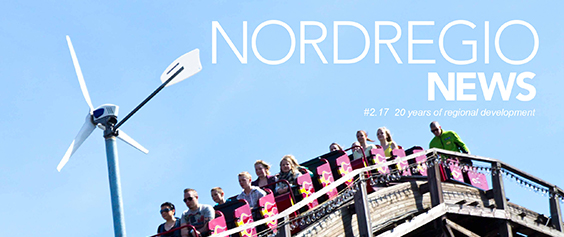Globalisation and urbanisation, climate change and new demographics have profound consequences – not just for large cities and metropolitan areas that often receive the most attention – but also for small- and medium-sized Nordic and Arctic cities. In the coming years, the Nordic thematic group on sustainable cities and urban development will explore the specificities of small- and medium-sized Nordic and Arctic cities, and how they can be made more sustainable. The first question to be investigated will be: what are the activities currently ongoing in smalland medium-sized Nordic and Arctic cities? In addition, we will analyse what small- and medium-sized cities are and how they may be defined in a Nordic context. Can small, urban and sustainable be a winning combination?
The challenges and potential for governing large Nordic city-regions and developing them toward greater sustainability were key concerns for the previous Nordic Working Group for Green Growth: Sustainable urban regions, which was active during 2013–2016. In the synthesis report, Towards Sustainable Nordic City-Regions (2016), some of the key challenges are highlighted; this report also indicates the potential for developing more sustainable urban regions through spatial planning and policy-making. Sustainability (social, economic and environmental) will continue to be a key issue for the new thematic group on sustainable cities and urban development. However, the main geographical focus will shift to small- and medium-sized Nordic and Arctic cities and their characteristics, in-line with the Nordic Cooperation Programme for Regional Development and Planning 2017–2020.
Policy and research themes
Many cities, irrespective of their size or location, struggle with facilitating economic growth while simultaneously trying to reduce their environmental impact, countering segregation, and creating attractive, inclusive urban environments. However, there are also unique challenges and potentials within small- and medium-sized Nordic and Arctic cities because of their local urban characteristics and socioeconomic conditions. These will be of key concern for the new thematic group, which will investigate this issue through different activities and projects over the next four years. Some activities and projects will focus directly on the social aspects of sustainability, which implies placing strategies for integration, housing, gender equality and quality of life at the core of urban development. Other projects will focus on the practical challenges of developing urban policies that contribute to attractive and sustainable urban environments in small- and medium-sized Nordic and Arctic cities. In the context of globalisation and urbanisation, there is also a need to ask fundamental questions about how urban and rural environments relate to one another, both as discursive categories and through material flow of people, goods, etc. The thematic group will also examine power relations in spatial planning; tensions between legitimacy and efficiency, where the challenge of combining democratically well-anchored inclusive planning processes with flexible market-oriented strategic planning processes are a key issue for further investigation.
Article continues below
Nordic added value
By focusing on social sustainability and spatial planning within smalland medium-sized Nordic and Arctic cities, the thematic group will contribute to the implementation of the cooperation programme. The objective of this programme is to increase knowledge about urban characteristics and socioeconomic conditions within smalland medium-sized Nordic and Arctic cities; it will also help improve governance practices for sustainable development in these cities based on their local urban characteristics and socioeconomic conditions. Furthermore, the group’s projects and activities will deepen our understanding of the linkages and external relations (regional, national and global) of small- and medium-sized Nordic and Arctic cities, with a focus on urban-rural relations. Implementing these projects at a Nordic policy-level, rather than a within a national context, clearly creates added value. The most explicit policy objective of the thematic group is to learn and spread knowledge about the characteristics of small- and medium-sized Nordic and Arctic cities. This approach will provide added value for members of the thematic group and Nordregio, as well as for our target groups: policy makers and civil servants in the Nordic region working with urban planning and regional development at local, regional and national authorities. Through an analysis of the local urban characteristics, socioeconomic conditions and external relations of small- and medium-sized Nordic and Arctic cities, the thematic group will also contribute to both planning and urban theory, as well as international urban planning practices.
UP FRONT WITH SMALL AND MEDIUM SIZED NORDIC TOWNS
Column by Guro Voss Gabrielsen and Peter Moltesen
Increased knowledge about the urban characteristics and socio-economic conditions in small- and medium-sized towns in the Nordic region is needed. This knowledge will facilitate the improvement of governance practices for sustainable development and lead to a deeper understanding of the relations between urban and rural areas. Thus, the new four-year thematic group for sustainable towns and urban development will focus on these issues. The Nordic region, including the Faroe Islands, Greenland and Åland, share factors that drive change, as well as opportunities and challenges. Economically, the Nordic region is performing well and growth is strong in several large urban areas. However, demographical change is a challenge. Society is ageing, and the age dependency ratio is increasing. In addition, we face the consequences of climate change, which encourage us to reduce CO2 emissions and adapt to new weather conditions. In small- and medium-sized Nordic towns, there is a need to resist segregation, create inclusive and resilient environments, leverage the potential of digitalisation toward developing smart cities, and overcome the divisions between towns and the surrounding countryside. Nordic countries have historically experienced similar urban development patterns and have similar planning and management strategies. However, there are also key differences both between and within Nordic countries, and lessons to be learned about urban and regional development. Planning for smart growth in small- and medium-sized towns includes all aspects of sustainability (i.e., social, economic and environmental). To nourish natural and human resources across the Nordic countries, we need to create liveable and attractive small- and medium-sized cities that will benefit the entire region.
This article is part of Nordregio News #2. 2017, read the entire issue here.



